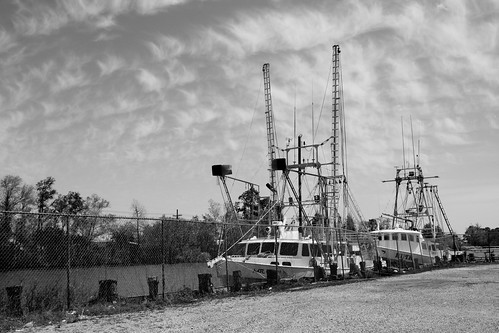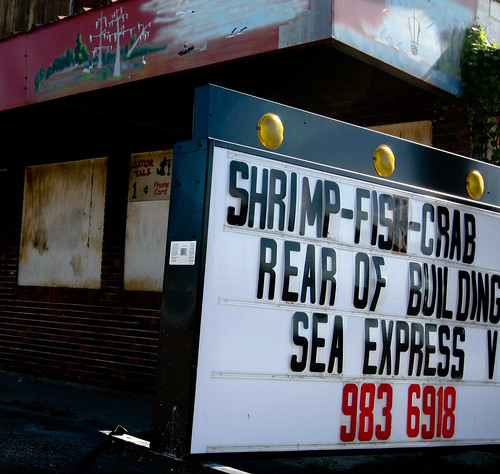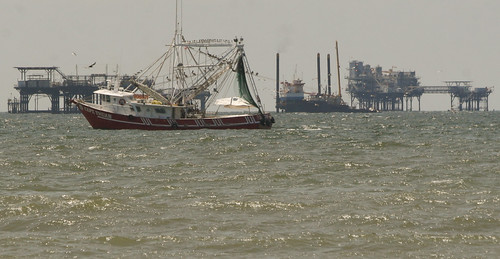
The entire Gulf Coast wetlands ecosystem is a delicate and profound balance of tides, winds, and ocean temperatures. It's almost cosmic. Tides push and pull vast and deep columns of water through narrow passes into lakes and bays and back out to the open ocean. This is a marine cardiovascular system on a continental scale, one supporting waters that roil with life. Winds move shallow layers of salt water toward the shore and push back with undercurrents of brackish and freshwater from lakes like Pontchartrain, Borgne, and Salvador. The coastal prairies and cypress swamps breath. Water temperatures and salt concentrations from the edge of the continental shelf and as close as the shallows of Chandeleur Sound and Barataria Bay trigger complex movements of sea life, telling them when to spawn and where to feed. Larger seasonal shifts provide signals to migratory birds, ushering them to land upon horizon-to-horizon beds of grass where they feed from the bounty all around.
And humans too live in this balance. For hundreds of years Cajun, Isleno, Creole, and African American fishermen have watched the tides and licked their fingers to the winds, following the shrimp, oysters, fish, and fowl of this land-meets-ocean edge world that their ancestors deemed a paradise. "Acadiana" from which "Cajun" is a modified anglicization which at its root refers to the idyllic place of Greek beauty and bounty, Arcadia.
But as
Nicolas Poussin's shepherds remind us, even "et in Arcadia ego" — interpretable as "even in paradise, death exist." The seeming paradise of southern Louisiana, resulting from cosmically dynamic interactions of ocean tides, wind, and river flows, has been morbidly upset by human greed. Beginning with the plantations in the 1700s vast forests along the Mississippi and distributary bayous were cleared, wetlands drained, levees erected and canals dug with slave labor. King cotton and queen sugar reigned supreme and befouled their hinterlands until the early twentieth century when the petrochemical industry and shipping industry eclipsed any ecological harm they had ever caused. The shift from agricultural plantations to chemical plants, from the extraction of crops to the extraction of minerals did more than upset the balance. Southern Louisiana is dying today. The land is disappearing. What land remains has been made toxic by the chemical plants and oil wells, dump ponds, slag and waste.
The Deepwater Horizon's explosion, and the "river of oil" now flowing from its ruptured well riser five thousand feet beneath the ocean surface is a catastrophe, the proportions of which are unknown and only beginning to be understood. Usually indifferent to the "everyday" environmental disasters surrounding their city —including almost monthly chemical leaks, explosions and oil spills on relatively smaller scales— New Orleanians can smell the oil coming at their coastline, blown by strong onshore winds.

Estimates of just how much oil is spewing forth from the undersea well are being upped on a daily basis. First BP claimed 1,000 barrels, but now they agree it's 5,000 and up. Some knowledgeable observers estimate that the flow is actually much higher. BP and the government are now desperately throwing resources at the oil slick, but the company's efforts have so far been mismatched to the speed at which the disaster is unfolding. Upset with the slow pace at which the federal government has marshaled resources, some in the Crescent City have already called this "Obama's Katrina," or a "slow-motion Katrina." The administration finally declared the spill an "event of national significance" on Thursday, April 29.
Billions and TrillionsShrimp are almost cosmic. Their life cycle is fused with geophysical forces - tidal and temperature movements propelled by the sun, earth, and moon, and by unfathomably complex wind patterns. Their life cycle begins far out in the ocean in waters of several hundred feet in depth. There are right now many trillions of shrimp eggs floating in the Gulf of Mexico, suspended in columns of water. April and May are in fact the heaviest spawning months, but the phenomenon occurs year round and follows both seasonal and episodic fluctuations in temperatures and tides.
From their early nauplius and protozoea larva stages they remain in the deep waters, the pelagic zone that is neither close to shore nor the ocean bottom. They move with the current, feeding off anything suspended around them, growing with amazing speed. From this stage to adulthood they provide a source of food for nearly everything that swims around them. They are reduced from many trillions to fewer trillions in number. Into the mysis larva and post-larva stage shrimp begin to move toward shore with flood tides. Strong northerly winds also push them toward the marshes when they rise toward the surface. They continue to feed and grow. From the juvenile through adult phases of their lives they live right along the coast, often letting surface flows, deep currents, and tides push them far into the brackish water marshes. Here they flit among the protection and abundance of the Spartina grass that is absolutely necessary for their survival. They forage along the shallow bottoms of bayous and bays. In these rich saltwater prairies they gain mass and prepare for the final stages in their lives.
Subtle signals in the water, from temperature to salinity, stimulate a final movement among adult shrimp, back out into the ocean. They congregate by the hundreds of millions in bayous and passes at night and await strong tides to pull them back out into the open Gulf where they will forage along the bottom at depths of up to several hundred feed. In this benthic zone they grow to full size and finally, when water temperatures increase, they rise and spawn, floating trillions upon trillions of eggs to renew the cycle.

But there are other sublime numbers beneath the Gulf: billions of barrels of oil and trillions of cubic feet of natural gas. These billions and trillions are measurable as billions of dollars in profits for corporations like BP, Halliburton and other major energy firms. It was with the discovery of oil in the swamps in the early 1900s that Acadiana, paradise found, was lost for good. The industry tore byzantine networks of canals through the marshes in order to reach prospects and haul drilling equipment in on barges. The shipping industry —a large portion of which services the petrochemical refineries upriver of New Orleans, which themselves were sited in proximity to the natural gas fields of the Gulf— did its part also to cut the wetlands into fragments. Concentrated salt water intruded where it should never had. Flood deposits of sediment were reduced and finally deleted as the Mississippi and other major waterways were locked into place. Subsidence, storms, the die-off of cypress and oak forests, and the melting of horizon stretching expanses of prairie grass, it all intensified after World War II. By the 1990s southern Louisiana had seen almost 2000 square miles of land disappear beneath the Gulf's waves. In the early 2000s the rate of land loss was 24 square miles a year, an area larger than Manhattan.
Atë, another word of greek origin comes to mind here. In Greek tragedies atë is the action of a protagonist leading to downfall as a result of their hubris. Atë means defying the gods. Few words better describe the cosmic folly some humans have brought upon the Gulf Coast today: tragic, hubristic nemesis. But here all literal refrains to Greek mythology and language fall flat. Unlike Greek tragedies where the hero brings shame and death upon himself, the slow-Katrina destruction of Acadiana is not clearly the fault of prideful Louisianans over-stretching their limits and pretending to godly levels of knowledge and power. Search as you might, you will find few people more humble and happy with simplicity and sustenance than the majority of New Orleanians, Cajuns, Creoles, Islenos, and African Americans who call southern Louisiana home.

Rather, the death of the wetlands is the result of corporate and state hubris, largely beyond the control of most Louisianans. Their state is being disappeared by a hydrocarbon hungry US economy and the major oil corporations that sit atop it. The gods, the cosmic forces of tides, river flows, winds and temperatures that is, are being defied by a small elite who seek the billions in profits at the expense of trillions of living beings, including millions of Louisianans who live in New Orleans, Houma, St. Bernard Parish, Terrebonne Parish, and down all the bayous.
Orders of MagnitudeThe latest National Oceanographic and Atmospheric Administration projections show that the oil slick from the Macondo blow-out has already reached portions of Louisiana's marshlands around the "bird food," the delta tip where the Mississippi terminates in the Gulf. It's also pushing oil ashore to the north, across portions of Chandeleur Sound's marshes. One internal NOAA estimate (dated April 30) reads:
"Strong SE winds of 15-25 kts are expected to continue through Saturday night. These winds will continue to bring oil towards the shoreline. Oil was observed today within several miles of the Delta between Garden Bay and Pass A Loutre. This could be the leading edge of the tarballs concentrating in the Mississippi River convergence as well as oil from an additional (unrelated) source near platform Ocean Saratoga. Shoreline impacts are likely to begin Thursday evening with the persistent onshore winds."
Documents leaked from NOAA and other federal authorities indicate that the well may soon begin to flow without any restrictions whatsoever, a scenario in which millions of gallons of oil could shoot into the Gulf every day. What is already a major disaster could very well become the second largest oil spill in history. The first, the oil apocalypse unleashed by Saddam Hussein and the United States military during the Gulf War in 1991 resulting in a much as 400 million gallons, would be hard to rival from a single well head, no matter how much pressure it's under. But the second largest spill, from the Ixtoc I well is very much like the Macondo blow-out. Ixtoc I spewed between 450,000 and 500,000 tons of crude oil, also into the Gulf of Mexico between June 1979 and March 1980, the time frame it took for Pemex to cap the well. Ixtoc I released about 10,000 barrels each day, exactly the same amount the Macondo blow-out is probably releasing right now if the latest candid projections of this spill are true.
A NOAA document dated from April 28 reads that
"[t]wo additional release points were found today in the tangled riser. If the riser pipe deteriorates further, the flow could become unchecked resulting in a release volume an order of magnitude higher than previously thought."Shrimp might almost be cosmic, but being almost cosmic is by no means unique to them. Many shellfish, fish, birds, crustaceans, and other life forms live in similarly sublime tandems with the tides and winds of the Gulf Coast. And that's the final damning reality of this catastrophic oil leak. Crude spewing from the Deepwater Horizon's well into the Macondo prospect is now riding the same wind-driven waves as the shrimp. It's coming ashore into the wetlands with them. BP and federal authorities have begun using dispersant chemicals to break up the oil patches and sink it beneath the surface. This strategy, however, may prove unwise. It will sink the oil so that it rides the deep currents and affects submarine life.
A 2005 National Academies study on the use of oil dispersants observes that little is actually known about the trade-offs between sinking oil slicks with chemicals versus struggling to contain them on the surface. These are two very different strategies that lead to very different kinds of exposure for sea life. After all, "dispersing" oil is simply a euphemism for sinking it in particulate form where it remains dissolved in columns of water, eventually settling on the ocean floor. For the shrimp, an indicator species in the sense that countless coastal species depend upon them for food, dispersants are perhaps just as bad as letting the slick reach the shore. In the former case they may be killed in open waters by oil particles, or at the bottoms where they feed. In the latter case their marsh habitats may be choked with crude oil. There seems to be no good strategy, just bad and worse. According the National Academies:
"the relative importance of different routes of exposure, that is, the uptake and associated toxicity of oil in the dissolved phase versus dispersed oil droplets versus particulate-associated phase, is poorly understood and not explicitly considered in exposure models. Photoenhanced toxicity has the potential to increase the impact “footprint” of dispersed oil in aquatic organisms, but has only recently received consideration in the assessment of risk associated with spilled oil. One of the widely held assumptions is that chemical dispersion of oil will dramatically reduce the impact to seabirds and aquatic mammals. However, few studies have been conducted since 1989 to validate this assumption."
And that;
"Many studies have shown that oil, floating above subtidal reefs [on the surface], has no adverse effects on the coral; however, if allowed to reach the shoreline, the oil may have long-term impacts to a nearby mangrove system. In addition, oil may persist in the mangrove system creating a chronic source of oil pollution in the adjacent coral reefs. The trade-off would be to consider the use of dispersants. Application of dispersant would result in dispersion of the oil in the water column and so provide some degree of protection to the mangroves; however, the reef system would now have to endure the consequences of an increase in dispersed oil in the water column...."
Furthermore, little is known about the ecosystemic effects of precipitating oil into columns of water, as well as the toxicity of the dispersants themselves, especially when combined with oil.
Is Acadiana lost? In truth the Cajuns and their kindred have been losing their idyllic wetlands for decades. Deepwater Horizon may just be the atë, if you will.







